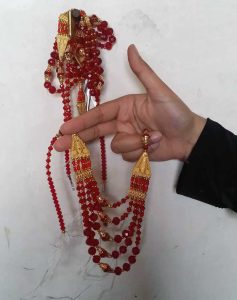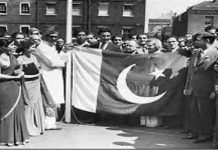Peshawar: Sakeena, an Afghan refugee, migrated to Pakistan when she was only five. She is now 40. All these years, she and her family has lived at the Khorasan refugee camp established in the outskirts of Peshawar in early 80s.
Sakeena is a skilled hand at carpet-weaving and the sole bread-earner of her family. She learned weaving from her grandmother and has passed on the skill to her children who help her weaving carpets at home.
“We were earning up to PKR 5000 per meter some months ago and then, suddenly, the price fell by a half,” says Sakeena.
Since the Soviet invasion of Afghanistan in the late 70s, millions of Afghan refugees have migrated to Pakistan. They have stayed in refugee camps in different part of tribal areas and Khyber Pakhtunkhwa (KP). Over the years, the Afghan lifestyle has enriched the local culture and among the skills they brought is carpet weaving, giving roots to a burgeoning Afghan carpet industry locally that has fed the international market. The local industry is dependent on carpet supply from refugee men and women like Sakeena working out of home in camps.
But conditions have grown bleak for the industry in recent months as ties between Pakistan and Afghanistan have soured amidst mutual accusations over terrorism in the two countries. Pakistan has taken a tough stance over refugees amidst fears that refugee settlements could be safe-havens for terrorists, closing them down and pushing Afghans to repatriate.
Data from the United Nations High Commissioner for Refugees shows that only 7,804 refugees returned to Afghanistan during the first six months of 2016. Between July and October, 2016, nearly 257,000 Afghan refugees returned to their country, 99 per cent of them from Pakistan. “This was more than thirty times the number that returned in the first half of the year, and the pace is still accelerating. The second week of October witnessed the highest weekly levels since 2009 and the rate of return is expected to remain high. With this evidence, UNHCR revised its projections from an estimated 221,000 refugee returnees from Pakistan in 2016 to some 365,000,” says a UNHCR briefing paper on repatriation of Afghan refugees.

With skilled Afghans repatriate to their country after decades of stay in Pakistan, the Afghan handicrafts and carpet industry has virtually collapsed with traders and manufacturers failing to meet market demand. The industry’s downfall is reflected in the Pakistan Economic Survey report for 2015-16: “During July-March Financial Year 2016, carpets and rugs worth $74.027 million were exported from Pakistan compared to $92.924 million previous year, showing a decrease of 20.34 per cent. While in quantity term the export of carpet and rugs decreased by 26.53 per cent.”
The negative trend continues with the Pakistani Economic Survey report for 2016-2017 revealing that export of carpets, rugs and mats registered negative growth in value by 17.3 per cent whereas its export quantity declined by 3.6 per cent during July- March 2017 compared to the same period last year. Further, in several Free Trade Agreement (FTA) concession lists with different countries, handmade carpets were excluded and there is no demand for machine made carpets.
“Shortage of skilled labour force has affected carpet demand and export,” says Mazhar ul Haq, Chairman Export Standing Committee KP Chamber of Commerce and Industries. “Earlier, more than 99 per cent of Afghan women were associated with the carpet-weaving industry. But now due to repatriation of Afghan refugees, the industry has collapsed.”
Haq said carpet-exporters in Lahore who had hired Afghan women to weave carpets had switched to other businesses as skilled workers have returned to Afghanistan. “No steps have been taken at the government or private level to transfer the skill to Pakistani citizens. The reason is that the carpet-traders association is based in Lahore whereas Peshawar is the weaving hub. We have won the best carpet design award in Germany for years but with the industry moribund, other countries are replacing us rapidly.”
He said India and Turkey had facilitated and assimilated Afghan weavers and both countries were now replacing Pakistan in the international market. “It is because of our wrong policies towards Afghanistan.”
About the fall in wages of weavers, Haq said carpet weavers were getting minimum wages compared to the past because demand for local carpets had fallen in the international market. “The fact that every fourth carpet used in the world is from Pakistan speaks volume about this industry,” says Haq.
On the other hand, for Afghan women like Zari, carpet weaving is the only source of income. She said women were considered bread-winners among the Uzbek, Turkman and Persian Afghan tribes while men were supposed to care for kids and responsible for other domestic activities like cleaning and cooking.
Mrs Iqbal Bano, Executive Member of Handicrafts Society of Khyber Pakhtunkhwa and Senior Vice President of Women Chamber of Commerce and Industries (WCCI), Peshawar, said that being a businesswomen, she faced major losses as technical skilled labour left due to repatriation of Afghan repatriation.
“As Afghans were settle here in our society since 30 years, their repatriation badly affected arts and crafts,” says Bano. “Recently I visited the old city market looking for antiques and handicrafts made by Afghan artisans, but was shocked that majority of the shops were closed due to refugee repatriation.”
She said Pakistanis never became manufacturers but were consumers of Afghan handicrafts “Afghans are hardworking people. Their women made laces for designer dresses that I used to export. Pakistani women could never deliver such intricate craftwork because those skills belong to Afghan women by culture and tradition.”
Bano said Afghan women made “abresham” – traditional silk embroidery – that was extremely difficult and time consuming to make. “It enjoys great value and demand in the international market. I buy handicrafts from Afghan women and supply them to the European market. With repatriation of skilled women, a vacuum has been created in the handicrafts industry.”
She said Afghan women made handicrafts for very low wages because they were refugees and had no legal or social protection. “They are willing to work for low wages for survival.”
Nabeela Farman, Manager Women Entrepreneurship Development at Small and Medium Enterprise Development Authority (SMEDA), a government platform for promotion of small businesses and artisans, said it would have been great if Pakistanis had adopted the craft and carpet-weaving skills from Afghan refugees. “It is still possible but needs serious efforts from government to give skills to a large population and help it contribute to national economy.”



